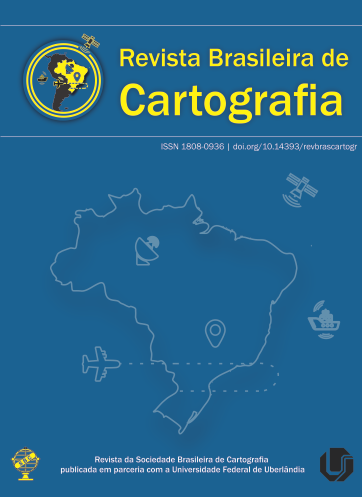Determinação dos Parâmetros de Desalinhamento Angular Usando uma Abordagem Ponto-a-Plano com Apoio de Campo Derivado de Nuvem LiDAR
Conteúdo do artigo principal
Resumo
A orientação direta de imagens é uma tarefa essencial para a extração de produtos fotogramétricos com alto grau de confiabilidade. Contudo, para se obter produtos cartográficos com acurácia e precisão posicional desejados é necessário realizar a calibração completa do sistema de mapeamento que envolve a determinação dos parâmetros de orientação interior da câmera e a estimativa dos parâmetros de montagem do sistema. Os parâmetros de montagem são representados pelo braço do sistema, que corresponde ao deslocamento linear entre a origem do sistema referencial INS e o centro perspectivo da câmera, e os parâmetros de orientação relativa, que representam o desalinhamento angular entre o sistema referencial do INS e o sistema referencial fotogramétrico. Este artigo apresenta um método para estimativa dos parâmetros de desalinhamento angular do sistema usando uma abordagem ponto-a-plano e apoio de campo extraído de dados LiDAR. O método proposto foi testado em um sub-bloco composto de seis imagens aéreas, sendo três na direção nordeste, e três na direção sudoeste. Os resultados obtidos mostraram que a abordagem desenvolvida estima, efetivamente, os parâmetros de desalinhamento angular propiciando acurácia posicional na determinação de pontos no espaço objeto.
Downloads
Detalhes do artigo
Seção
Autores que publicam nesta revista concordam com os seguintes termos:
- Autores mantém os direitos autorais e concedem à revista o direito de primeira publicação, com o trabalho simultaneamente licenciado sob a Licença Creative Commons Atribuição que permite o compartilhamento do trabalho com reconhecimento da autoria e publicação inicial nesta revista.
- Autores têm autorização para assumir contratos adicionais separadamente, para distribuição não-exclusiva da versão do trabalho publicada nesta revista (ex.: publicar em repositório institucional ou como capítulo de livro), com reconhecimento de autoria e publicação inicial nesta revista.
- Autores têm permissão e são estimulados a publicar e distribuir seu trabalho online (ex.: em repositórios institucionais ou na sua página pessoal) a qualquer ponto antes ou durante o processo editorial, já que isso pode gerar alterações produtivas, bem como aumentar o impacto e a citação do trabalho publicado (veja "O Efeito do Acesso Aberto").





